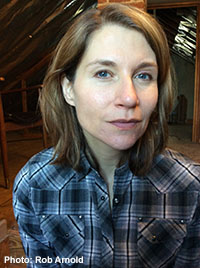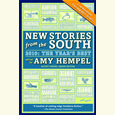Contracts with the Devil
In Jennifer Haigh’s new novel, Heat and Light, energy companies choose profits over safety
A new era of the protest novel has arrived. The grand American tradition of politically charged exposés of corruption and malfeasance—a literary line that runs from Harriet Beecher Stowe to Upton Sinclair and John Steinbeck—has found new energy in the hands of twenty-first-century novelists fed up with environmental degradation. Jonathan Franzen’s Freedom and Christopher Scotton’s The Secret Wisdom of the Earth took on strip mining in Appalachia, and Tom Cooper’s The Marauders revealed the long-term suffering caused by the Deepwater Horizon oil spill in 2010. Now Jennifer Haigh’s new novel, Heat and Light, addresses the calamity of fracking.
 Though Haigh makes it clear from the start that energy exploration inevitably carries environmental costs, she fills her novel with characters who don’t have the luxury of making disinterested decisions about the stewardship of natural resources. Heat and Light is not a jeremiad against fracking, in other words; it’s a complex exploration of all the forces at work in environmental disasters. The novel is set in Bakerton, Pennsylvania, in the Saxon Valley, a region that has been sustained by the energy industry for 150 years. The country’s first oil wells were drilled there in 1858, and for decades the region’s economy ebbed and flowed with the fortunes of the coal mines (a period Haigh documents in her 2004 novel Baker Towers). Bakerton has been declining since the deep mines began to close in the 1960s.
Though Haigh makes it clear from the start that energy exploration inevitably carries environmental costs, she fills her novel with characters who don’t have the luxury of making disinterested decisions about the stewardship of natural resources. Heat and Light is not a jeremiad against fracking, in other words; it’s a complex exploration of all the forces at work in environmental disasters. The novel is set in Bakerton, Pennsylvania, in the Saxon Valley, a region that has been sustained by the energy industry for 150 years. The country’s first oil wells were drilled there in 1858, and for decades the region’s economy ebbed and flowed with the fortunes of the coal mines (a period Haigh documents in her 2004 novel Baker Towers). Bakerton has been declining since the deep mines began to close in the 1960s.
Heat and Light opens in 2010, when representatives of natural-gas companies appear to offer landowners in the area a lifeline: $25 per acre for the right to drill, plus one percent of any revenue the land yields in natural gas. Many farmers, whose humble lives can be ruined by a single bad season, leap at the offer of financial security. Rich Devlin sees the gas leases as an “exit strategy” that will allow him to quit his job as a prison guard and pursue his dream of running a dairy operation on his family’s sixty acres. Others are dubious about the gas companies’ claims that their extractions “are so far down you’ll never know we’re there.” Devlin’s neighbors, Mack and Rena (“the lesbian dairy farmers”), refuse to sign the lease because they fear that drilling will taint their organic certification and deprive them of their market niche. By 2012, when drill rigs have sprouted all around the valley, many other Bakerton citizens have come to believe the price of economic resurgence is too high.
But in this novel, fracking is disastrous from the jump. Before the drilling even begins, acres must be cleared for a drill rig “the size of a shopping mall.” Earthmovers dig out a containment pond that is “larger than the town swimming pool” and trench another pit—this one for collecting “earth turds”—that is “half the size of a football field.” The drilling companies must get twentieth-century demolition out of the way before unleashing the really freaky twenty-first-century nastiness.
 As Lorne Trexler, a geologist from a nearby college, describes it, “hydraulic fracturing” involves “a million gallons of water pumped into the ground at unimaginably high pressure … to break up the underground rock.” Worse, “fracking fluid isn’t just water. It’s mixed with sand and whatever chemical cocktail they think is going to work.” The energy companies won’t reveal what chemicals they use, claiming that to do so would “destroy their competitive advantage.” But when the wastewater from fracking is dumped into “ordinary sewage treatment plants,” as Trexler and his research team learn, the result is “known carcinogens” released into Pennsylvania’s waterways. And there’s nothing they can do about it: in 2005, lobbyists convinced Congress to exempt fracking fluid from the Clean Water Act (a rider referred to as the “Halliburton Loophole”), giving oil companies a license to poison the countryside with impunity.
As Lorne Trexler, a geologist from a nearby college, describes it, “hydraulic fracturing” involves “a million gallons of water pumped into the ground at unimaginably high pressure … to break up the underground rock.” Worse, “fracking fluid isn’t just water. It’s mixed with sand and whatever chemical cocktail they think is going to work.” The energy companies won’t reveal what chemicals they use, claiming that to do so would “destroy their competitive advantage.” But when the wastewater from fracking is dumped into “ordinary sewage treatment plants,” as Trexler and his research team learn, the result is “known carcinogens” released into Pennsylvania’s waterways. And there’s nothing they can do about it: in 2005, lobbyists convinced Congress to exempt fracking fluid from the Clean Water Act (a rider referred to as the “Halliburton Loophole”), giving oil companies a license to poison the countryside with impunity.
Haigh’s characters understand that dealing with gas companies entails a Faustian bargain: they are willing to accept inconvenience and noise, and a degree of environmental damage, in exchange for a financial windfall. Already accustomed to seeing the countryside decimated by coal mines, citizens in Saxon Valley welcome the gas companies at first and begin to organize protests against them only when the threat of irreversible harm becomes too grave to ignore.
Haigh places the current conflict over fracking in the context of energy controversies through the years, including the ravages of coal mining, the disposal of toxic waste, and the oil crisis of the seventies. One chapter involves a flashback to the Three Mile Island disaster in 1979, when a nuclear reactor sent a toxic cloud drifting over Pennsylvania that may have contributed to higher cancer rates. What those families learned then, and what Bakerton is learning now, is that there is effectively no corporate accountability for public safety.
Haigh’s novel is rich in tactile details, the feel of the soil and the texture of poverty. Bad smells permeate the story, a warning that something unnatural has invaded the land. The energy company’s barracks “reek of pesticide and newness, the manufactured smell of trash bags, cheap lawn furniture.” Rich Devlin, who showers at work to rid himself of prison stench, discovers that the water from his family’s well has begun to smell like natural gas. In the Bakerton of Heat and Light, a hypochondriac like Devlin’s wife Shelby might be an asset: in a world run by corporations, the paranoiac could be the canary in the coalmine, sniffing out contamination before it is too late.

Sean Kinch grew up in Austin and attended Stanford University as an undergraduate. He returned to Austin, where he earned a Ph.D. in modern fiction from the University of Texas. He now teaches English at Montgomery Bell Academy in Nashville.


